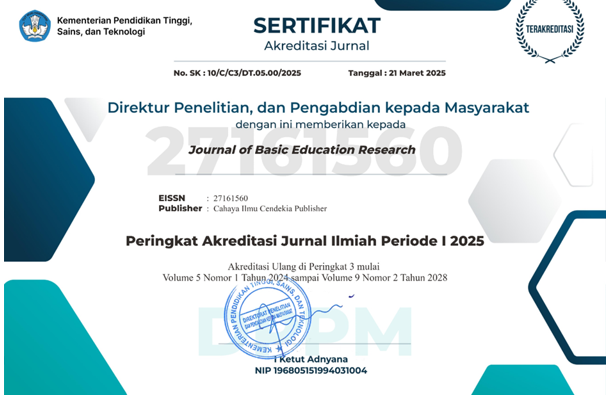Kemampuan Siswa Pendidikan Anak Usia Dini Dalam Mengenal Bilangan
Abstract
Tujuan Penelitian: Untuk melihat kemampuan siswa PAUD dalam mengenal bilangan.
Metodologi: The type of research used is quantitative which uses a research design survey. Dimana Jumlah dari seluruh sampel dari penelitian ini adalah 45 siswa yang diambil dengan berdasarkan teknik total sampling. Data kemudian dianalisis dengan bantuan aplikasi SPSS 21 untuk mencari statistik deskriptif berupa mean, min, max, dan kategori
Hasil Temuan: Dari hasil analisis yang telah dilakukan, ditemukan bahwa terdapat kemampuan menyebut bilangan dan mengenal lambang bilangan dengan kategori baik, hal ini menunjukkan bahwa siswa memilliki kemampuan dalam mengenal dan menyebutkan bilangan
References
M. Syah. “Psikologi Pendidikan,” PT Remaja Rosdakarya, 2014.
Y. Papadiamantaki, G. Fragoulis, and E. Soroliou. “Student Engagement in Higher Education: Participation in Greek Student Elections.” Academia Journal, vol.6, no.1, 2016.
Asrial, Syahrial, D. A. Kurniawan, R. Septiasari, “Hubungan Kompetensi Pedagogik Dengan Kompetensi IPA Mahasiswa Pendidikan Guru Sekolah Dasar,” Pedagogia: Jurnal Pendidikan, vol. 8, no. 2, pp. 149-157, 2019.
D. R. Permatasari, H. Soegiyanto, and B. Usodo. “The use of discovery learning model with rme approach viewed from interpersonal intelligence,” Journal of Education and Learning (EduLearn), vol.13, no1, pp. 87, 2018.
A. Asrial, S. Syahrial, D. A. Kurniawan, F. Chan, P. Nugroho, R. A. Pratama, and R. Septiasari, “Identification: The Effect Of Mathematical Competence On Pedagogic Competency Of Prospective Teacher,” Humanities & Social Sciences Reviews (HSSR), vol. 7, no. 4, pp. 85–92, 2019.
M. Fotis. "Educational preferences of secondary school graduates: The case of the University of Patras,” Academia Journal, vol.1, no.1, 2011.
V. Hubert. “Students will learn to increase their knowledge and knowledge to get education that is in accordance with existing standards,” Academia Journal, vol.4, no. 1, 2014.
S. Syahrial, A. Asrial, D. A. Kurniawan, P. Nugroho, R. Septiasari, R. A. Pratama, and R. Perdana, “Increased Behavior of Students' Attitudes to Cultural Values Using the Inquiry Learning Model Assisted Ethno constructivism,” Journal of Educational Science and Technology (EST), vol. 5, no. 2, pp. 166-175, 2019.
Astalini, D. A. Kurniawan, U. Sulistiyo, R. Perdana, and S. Susbiyanto. “E-Assessment Motivation in Physics Subjects for Senior High School,” International Journal of Online and Biomedical Engineering (iJOE), vol.15, no.9, pp. 4-15, 2019.
Astalini, D. A. Kurniawan, Darmaji, L. R. Sholihah, and R. Perdana. “Characteristics Of Students’ Attitude To Physics In Muaro Jambi High School,” Humanities & Social Science Reviews (HSSR), vol. 7, no. 2, pp. 91-99, 2019.
Darmaji, D. A Kurniawan, Astalini, A. Lumbantoruan, and S. C. Samosir. “Mobile Learning In Higher Education For The Industrial Evolutioin 4.0: Perception and Response of Physics Practicum,” International Journal of Interactive Mobile (IJIM), vol. 13, no. 9, pp. 4-20, 2019.
Maison., Astalini., D. A. Kurniawan, R. Perdana, and L. Anggraini. “The Phenomenon of Physicology Senior High School Education: Relationship of Students’ Attitudes towards Physics, Learning Style, Motivation,” Universal Journal of Educational Research,.vol. 7, no. 10, pp. 2199-2207, 2019
A. Asrial, S. Syahrial, D. A. Kurniawan, and N. Amalina, “Analisis Hubungan Kompetensi Bahasa Indonesia Terhadap Kompetensi Pedagogik Mahasiswa Pendidikan Guru Sekolah Dasar,” Premiere Educandum: Jurnal Pendidikan Dasar dan Pembelajaran, vol. 9, no. 1, pp. 1–8, 2019.
D. A. Kurniawan, A. Astalini, D. Darmaji, and R. Melsayanti, "Students’ Attitude Towards Natural Sciences," Int. J. Eval. & Res. Educ, vol 8, no. 3, pp. 455-460, 2019.
A. Asrial, S. Syahrial, D. A. Kurniawan, M. Subandiyo, and N. Amalina, “Exploring Obstacles in Leanguage Learning Among Prospective Primay School Teacher,” International Journal of Evaluation and Research in Education, vol. 8, no. 2, pp. 249-254, 2019
D. Darmaji, D. A. Kurniawan, and A. Suryani, “Effectiveness of Basic Physics II Practicum Guidelines Based on Science Process Skills,” JIPF (Jurnal Ilmu Pendidikan Fisika, vol. 4, no. 1, pp. 1-7, 2019
D. Darmaji, D. A. Kurniawan, and I. Irdianti, “Physics Education Students Science Process Skills in Universitas Jambi,” International Journal of Evaluation and Research in Education (IJERE). Vol. 8, no. 2, 2019
S. Suyanto. “Konsep dasar pendidikan anak usia dini,” Departemen Pendidikan Nasional Direktorat Jenderal Perguruan Tinggi Direktorat Pembinaan Pendidikan Tenaga Kependidikan dan Ketenagaan Perguruan Tinggi, 2005
N. Mathers, and H. Amanda. “Surveys And Questionnaires,” National Instutude For Health Research: East Midlands, 2009
D. A. Kurniawan, R. Perdana, and D. Kurniasari, “Identification Of Student Attitudes Toward Physics Learning At Batanghari District High School,” The Educational Review, USA, vol. 2, no. 9, pp. 475-484, 2018
A. Astalini, M. Maison, M. Ikhlas, and D. A Kurniawan, “The Development Of Students Attitude Instrumen Towards Mathematics Physics Class,” Edusains, vol. 10, no. 1, pp. 46-52, 2018
D. Darmaji, D.A. Kurniawan and A. Lestari, “Deskripsi Keterampilan Proses Sains Mahasiswa Pendidikan Fisika Pada Praktikum Suhu dan Kalor,” JRKPF UAD, vol. 5, no. 2, pp. 68-72, 2018
D. Darmaji, D. A. Kurniawan, A. Suryani, and A. Lestari, “an identification of physics pre-service teachers science process skills yhrough science process skills-based practicum guidbook,” Jurnal Ilmiah Pendidikan Fisika Al-Biruni, vol. 7, no. 2, pp. 239-245, 2018
D. E. Papalia. “Human development perkembangan manusia edisi 10,” Salemba Humanika, 2009.
H. Rasyid, Mansyur, and Suratno. “Asesmen perkembangan anak usia dini,” Multi Pressindo, 2009.
Creswell, John W. “Educational Research: Planning, Conducting, And Evaluating Quantitative And Qualitative Research,” Pearson, 2012.
L. Cohen, L. Manion, and K. Morrison. “Research Methods In Education,” Routledge, 2005.
Sriningsih. “Pembelajaran matematika terpadu untuk Anak Usia Dini,” Pustaka Sebelas, 2008.
Coupley. “The young Child and Matematics,” National Associacion for the Education of Young Children, 2001.
D. Darmaji, A. Astalini, D. A. Kurniawan, H. Parasdila, I. Irdianti, S. Susbiyanto, K. Kuswanto, and M. Ikhlas, “E-Modul Based Problem Solving In Basic Physics Practicum For Science Process Skills,” Internasional Journal of Online and Biomedical Engineering (iJOE), vol. 15, no. 15, pp. 4-17, 2019
Sujiono. “Menu Pembejajaran Anak Usia Dini,” Yayasan Pendidikan citra Indonesia, 2006.
A. Astalini, D. A. Kurniawan, and A. D. Putri, “Identifikasi Sikap Implikasi Sosial Dari IPA, Ketertarikan Menambah Waktu Belajar IPA, Dan Ketertarikan Berkarir Dibidang IPA Siswa Smp Sekabupaten Muaro Jambi” Tarbiyah: Jurnal Ilmu Kependidikan, vol. 7, no. 2, pp. 92-108, 2018
N. M. Tajudin, R. A. Tarmizi, W. W. Ali, and M. M. Konting. “The use of graphing calculator in teaching and learning mathematics: Effects on performance and metacognitive awareness,” In Proceeding of the 3rd National Conference on Graphing Calculators, pp. 149-172, 2008.
D. A. Kurniawan, A. Astalini, D. Darmaji, R. Melsayanti, “Student’s Attitude Towards Natural Science,” International Journal of Evaluation and Research in Education (IJERE), vol. 8, no. 3, pp. 463-468, 2019
D. A. Kurniawan, A. Astalini, D. Darmaji, and R. Melsayanti, "Students’ attitude towards natural sciences," Int. J. Eval. & Res. Educ, vol 8, no. 3, pp. 455-460, 2019.
Copyright (c) 2020 Suciyati Suciyati, Masrita Masrita

This work is licensed under a Creative Commons Attribution-NonCommercial 4.0 International License.
Authors who publish with this journal agree to the following terms:
- Authors retain copyright and acknowledge that the Journal of Basic Education Research is the first publisher licensed under a Creative Commons Attribution 4.0 International License.
- Authors are able to enter into separate, additional contractual arrangements for the non-exclusive distribution of the journal's published version of the work (e.g., post it to an institutional repository or publish it in a book), with an acknowledgment of its initial publication in this journal.
- Authors are permitted and encouraged to post their work online (e.g., in institutional repositories or on their website) prior to and during the submission process, as it can lead to productive exchanges and earlier and greater citation of published work.





.png)


.png)
.png)


















